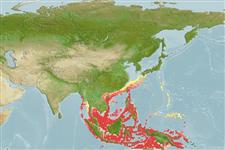>
Eupercaria/misc (Various families in series Eupercaria) >
Lutjanidae (Snappers) > Etelinae
Etymology: Pristipomoides: Greek, pristis = saw + Greek, poma, -atos = cover, operculum + Greek, oides = similar to (Ref. 45335).
More on author: Bleeker.
Environment: milieu / climate zone / depth range / distribution range
Ecologie
marien demersaal; diepte 40 - 120 m (Ref. 12260). Tropical; 32°N - 12°S, 93°E - 157°E (Ref. 55)
Eastern Indian Ocean: Andaman Sea. Western Pacific: New Guinea to Sumatra, north to the Ryukyu Islands. Present in Australia from the North West Shelf to Tweed Heads in New South Wales (Ref. 6390). Records from the western Indian Ocean need verification.
Lengte bij maturiteit / Grootte / Gewicht / Leeftijd
Maturity: Lm ?, range 28 - ? cm
Max length : 70.0 cm TL mannelijk / geslacht onbekend; (Ref. 55); max. gepubliceerd gewicht: 2.2 kg (Ref. 1451); max. gerapporteerde leeftijd: 11 Jaren (Ref. 3090)
Dorsale stekels (totaal) : 10; Dorsale zachte stralen (totaal) : 11 - 12; Anale stekels: 3; Anale zachte stralen: 8. Interorbital space flat. Bases of dorsal and anal fins without scales, their last soft rays extended into short filaments. Pectoral fins long, reaching level of anus. Scale rows on back parallel to lateral line. Overall color rosy red; the top of the head with longitudinal vermiculated lines and spots of brownish yellow; the dorsal fin with wavy yellow lines.
Sharptooth snappers are found in tropical and sub-tropical deep waters. They are found in schools and live in areas of hard, rocky and uneven sea floor (Ref. 27354). They feed on benthic invertebrates and fishes.
Studies in South China Sea (Ref. 28116) and Hawaii (Ref. 28117) suggest that this species is a serial spawner (Ref. 28115).
Allen, G.R., 1985. FAO Species Catalogue. Vol. 6. Snappers of the world. An annotated and illustrated catalogue of lutjanid species known to date. FAO Fish. Synop. 125(6):208 p. Rome: FAO. (Ref. 55)
Status op de Rode Lijst van het IUCN (Ref. 130435: Version 2024-1)
Gevaar voor de mens
Harmless
Gebruik door de mens
Visserij: van minder commercieel belang
Tools
Speciale rapporten
Download XML
Internetbronnen
Estimates based on models
Preferred temperature (Ref.
123201): 23.4 - 28.2, mean 27.2 °C (based on 260 cells).
Fylogenetische diversiteitsindex (Ref.
82804): PD
50 = 0.5005 [Uniqueness, from 0.5 = low to 2.0 = high].
Bayesian length-weight: a=0.01202 (0.00706 - 0.02048), b=2.95 (2.81 - 3.09), in cm total length, based on LWR estimates for this species & Genus-body shape (Ref.
93245).
Trofisch niveau (Ref.
69278): 4.2 ±0.61 se; based on food items.
Generation time: 4.3 ( na - na) years. Estimated as median ln(3)/K based on 2
growth studies.
Weerstandsvermogen (Ref.
120179): Gemiddeld, minimale populatieverdubbelingstijd 1,4-4,4 jaar (K=0.25; tmax=11; Fec=760,000).
Fishing Vulnerability (Ref.
59153): Moderate vulnerability (39 of 100).
Nutrients (Ref.
124155): Calcium = 85.3 [32.6, 191.8] mg/100g; Iron = 1.01 [0.55, 1.83] mg/100g; Protein = 18.3 [16.4, 19.9] %; Omega3 = 0.239 [0.141, 0.405] g/100g; Selenium = 64 [34, 134] μg/100g; VitaminA = 27.9 [8.6, 96.7] μg/100g; Zinc = 0.788 [0.521, 1.156] mg/100g (wet weight);
